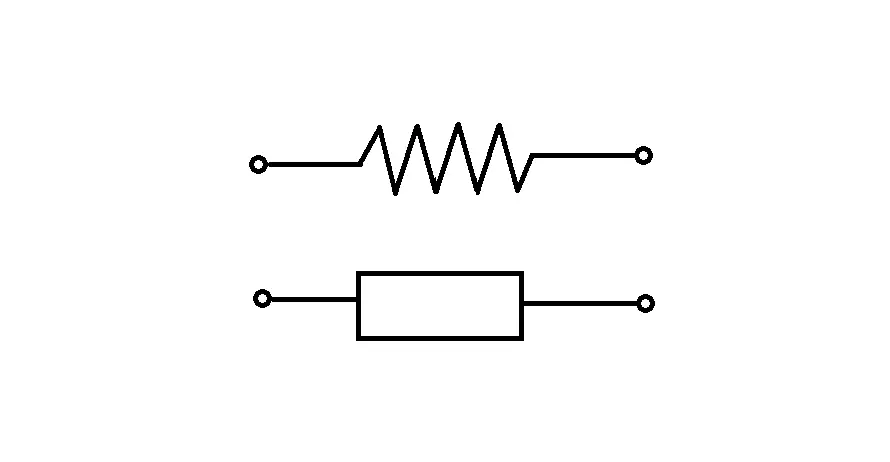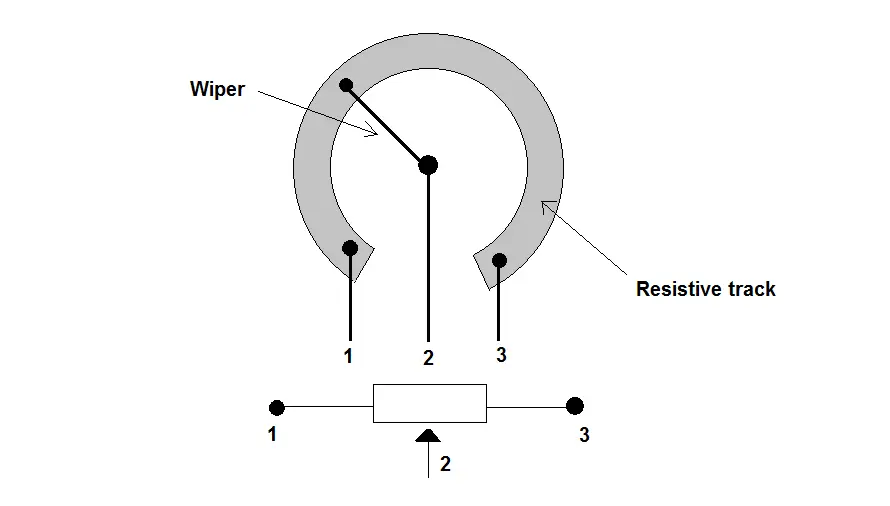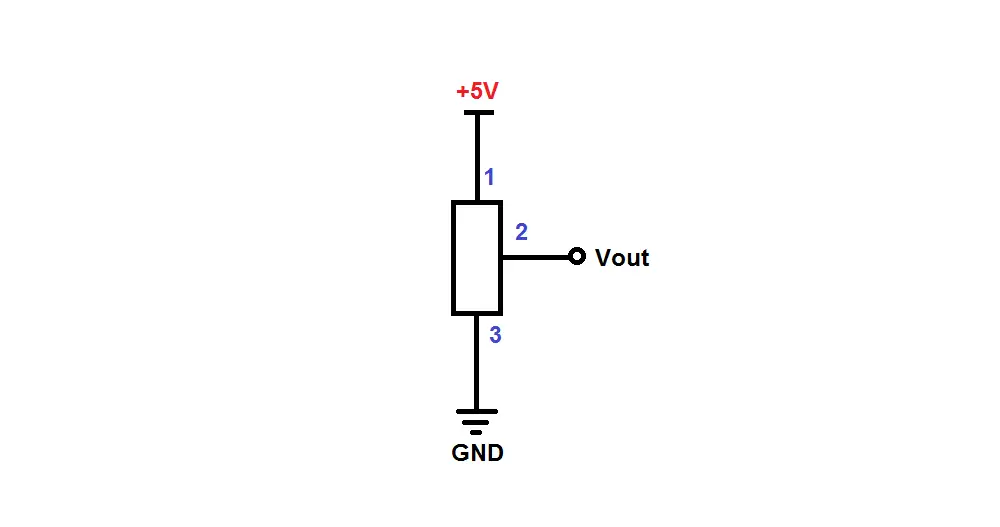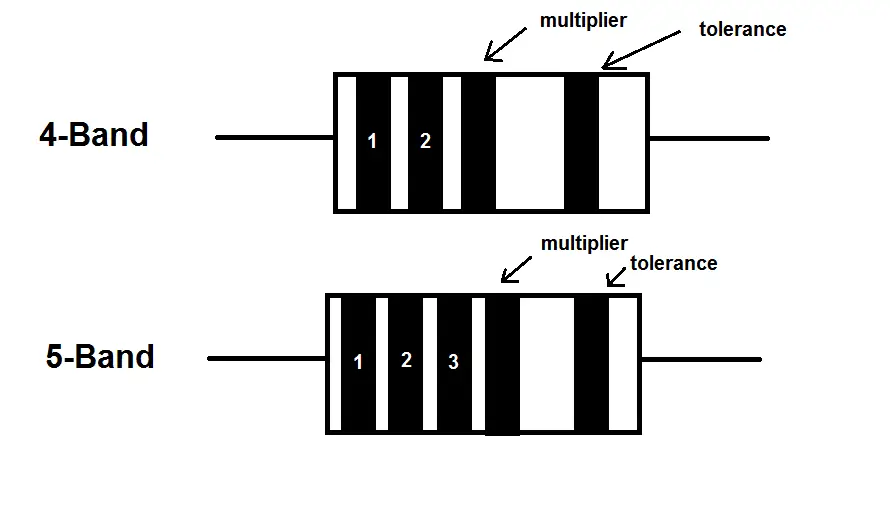There are many different components that exist in the electrical and electronic world, each having its own unique ability serving a specific purpose in a circuit.
Components such as capacitors, inductors, diodes, thermistors, transformers, etc.
However, one very crucial component that is missing from that list is the Resistor. I would be surprised if you weren’t able to find one in a circuit.
The resistor can be further divided into two categories; Fixed Resistor and Variable resistor.
But, what is the difference between a fixed resistor and variable resistor? The main difference between a fixed resistor and variable resistor is that a fixed resistor has a fixed resistance, whereas the variable resistor has variable resistance (it has a range of resistances which you can set using a knob or slider).
There is more to just resistance when it comes to the differences between a fixed and variable resistor. Things like construction, application, etc.
This article shall take a closer, more in-depth look.
Deeper look at a fixed and variable resistor
Let’s take a closer look at the fixed and variable resistor. This will help you better understand the differences between the two later on.
What is a resistor?
Let’s take a closer look at the Resistor.
As mentioned at the start, there are many different types of components and devices in the electrical and electronic world, each with their own unique abilities which help perform a certain function within a circuit.
The Resistor is a fundamental electronic component that can be found in almost all circuits.
So what is the definition of a resistor?
A resistor is a passive electrical and electronic component, whose main purpose is to ‘resist’ the flow of current in a circuit. Also, rather than having an ambiguous resistance value, resistors are created with a set resistance value.
The bigger the resistance, the less current can flow, and the lower the resistance, the more current can flow.
It is known as a passive component due to the fact that it has no means of generating its own power, but rather dissipates power in the form of heat.
The fixed resistor
As the name might suggest, fixed resistors have a resistance that is fixed regardless if there is a change in voltage.
It cannot physically change its resistance.
For example, if you bought a 10 ohm fixed value resistor, this is the only resistance that the resistor is going to be able to provide.
In an ideal world, the resistor would provide a fixed resistance at all times. However this is not the case, as their resistance varies slightly with temperature (which we shall look at later).
Fixed resistors are the most commonly used in circuits. Their value is chosen during the circuit design phase using calculations using Ohm’s Law.

Different types of fixed resistor
Below are the different types of fixed resistor available;
- Wire Wound
- Carbon composition
- Carbon film
- Metal Film
- Metal-oxide film
- Metal glaze
- Foil
Wire wound fixed resistor
This type of resistor has an insulating ceramic rod that is wrapped in wire (with the wire being copper due to its high conductivity).
It is the most widely used type of fixed resistor.

Carbon composition fixed resistor
Have a cylindrical form with metal caps at either end of the cylinder. Inside the cylinder is a substance that is a mixture of carbon power and ceramic.
While used primarily in the early 1960’s, this type of fixed value resistor isn’t used a lot anymore due to its high cost and low stability.
Carbon film fixed resistor
Has a very similar construction to the carbon composition resistor. However, a carbon film is placed atop a ceramic substrate.
This type of fixed value resistor produces less noise when compared to carbon composition resistors.
Metal film fixed value resistor
The metal film resistor has the same construction as the carbon film. But, rather than using carbon as the material of the film, other metals are used.
Metals used in metal film resistors are usually Nickel Chromium, Tin or Antimony.
The resistance of metal film is less affected by temperature.
Metal oxide fixed value resistor
Has the same construction as carbon film, and metal film resistors. Again, what sets them apart is the material used.
The film in this resistor is a metal oxide such as Tin Oxide.
They cost less compared to carbon composition resistors, and can be used at higher temperatures.
Metal glaze fixed value resistor
Use a composition of glass powder and metal particles to restrict the flow of current.
Its resistance is also less affected by temperature.
Foil fixed value resistor
Last but not least are foil resistors.
They are made using an alloy (a material composed of two or more metallic elements). The foil is created from an alloy of nickel and chromium.
Of all the different types of construction for fixed value resistors, these are the most accurate and stable.
They also produce far less noise.
What is a variable resistor?
Next, we have the Variable Resistor.
This type of resistor has the ability to vary its resistance between two set values (with the lower usually being 0 ohms).
Note, this does not mean it’s restricted to those values, it can have a range of values which sit within the range of its lower and upper resistance limits. Its incremental value depends on the resolution of the variable resistor.
For example if you have a 10k variable resistor, you would be able to set its resistance at any value between 0 and 10k ohm.
So, you could set it at 10, 100, 1k, 2.5k, 5.7k, 8k etc.
Below are the most commonly used circuit symbols for variable resistors;

Construction of a variable resistor
The construction of a variable resistor is basically a fixed resistive element along with a wiper that sits on the resistive element.
The slider can be adjusted (by means of a slider or knob which you control) to sit anywhere along the resistive element thereby adjusting the overall output resistance.

As you can see there are three terminals and the resistive element is connected to terminals 1 and 3. To use it as a variable resistor, you have to make connections to terminal 1 and 3.
Other abilities of a variable resistor
The variable resistor is quite the versatile component.
The great thing about it is that it has an added ability, which is to vary voltage. When used to vary voltage, it is known as a Potentiometer.
To use it as a potentiometer, you would connect terminals 1 and 3 to GND and VCC (it doesn’t matter which terminal gets connected to what).
The varied voltage is then presented at terminal 2.

The main difference between a fixed resistor and variable resistor
So, we have learnt what a fixed and variable resistor are individually. But, what is the main difference between the two?
While the overall function of both remains the same, which is to provide resistance, the main difference between a fixed and variable resistor is their Resistance values.
Fixed resistors are created to have a specific known resistance value that is set and cannot be changed (hence why they are called fixed resistors).
Variable resistors on the other hand offer a range of resistances (between their minimum and maximum values) which you can alter by means of a slider or knob.
Also, they are used for specific applications in circuits (which we shall cover later in the article).
The main purpose of a fixed resistor and variable resistor
But, why do we need resistors in the first place?
Every electrical and electronic component has something known as a Power Rating.
This is a value that indicates how much electrical power is needed by the component to work effectively. Also, the power rating value indicates the maximum allowable electrical power the device or component can handle.
Exceeding this value will cause damage to the component. The power rating can be broken further into; Voltage ratings, and Current ratings.
This is because power is a product of voltage and current ( P = V x I).
Components will have values for maximum voltage and maximum current ratings that should not be exceeded.
Resistors are important as they allow us to protect components in circuits by limiting the current so that the current ratings of that component are not exceeded (and therefore power rating as well).
Sometimes you might not be able to change the power supply (which means the voltage is fixed), so you will need a resistor to limit the other variable in the power equation (in this instance the current).
However, while resisting current is their main task, they are used in electrical and electronic circuits for other reasons to achieve certain outcomes.
Let’s take a look at different uses of fixed and variable resistors.
Applications of a fixed resistor
If you were to pry open any electronic device and look at its circuits, I would be surprised if you didn’t find at least one resistor.
Fixed resistors have many uses for different applications. Some of the uses include;
- Reducing current flow
- Adjusting signal levels
- Dividing voltages
- Biasing active elements
- Terminating transmission lines
- Pull-up / Pull-down
Some of the many applications;
- High frequency instruments
- Power control circuitry
- DC power supplies
- Filter circuit networks
- Amplifiers
- Oscillators
- Telecommunications
- Electronic measuring instruments
- Wave generators
- Transmitter
- Modulators / Demodulators
- Instrumentation
- Voltage regulators
- Feedback amplifiers
Applications of a variable resistor
While not as common as its conventional counterpart, variable resistors have more specific applications compared to fixed resistors.
Common uses of a variable resistor include;
- Varying resistance (when used as variable resistor)
- Varying voltage (when used as a potentiometer)
Common applications of a variable resistor are;
- Televisions
- Audio control (Radios, Stereo systems, Cars, etc)
- Oscillators
- Motion Control
- Transducers
- Home electrical appliances
- Motor control (electric vehicles, scooters, golf carts, etc)
Different types of variable resistor and their applications
The variable resistor we just looked at is just one of the most common types which varies its resistance mechanically (twisting a knob, or moving a slider).
However, there are other forms of variable resistors each having its own unique way of varying resistance.
Let’s take a quick look at each of them.
Light dependent resistors
The first on the list are Light Dependent Resistors (LDRs).
However, they have many other aliases that you might know it by, which include, Photoresistor, Photocell, or Photoconductor.
The resistance of light dependent resistors changes depending on varying light levels. The amount of resistance that changes depends on the intensity of light, as well as the sensitivity of the LDR.
The less light that the LDR is subject to, the higher its resistance (in the order of megaohms) and the more light that shines upon the LDR, the lower its resistance (few hundred ohms).
They are created using a semiconducting material that gives them their light sensing abilities.
Common applications of the light dependent resistors;
- Smoke alarms
- Photographic light meters
- Streetlights
- Burglar alarms
Force sensitive resistor
Next up we have the Force Sensitive Resistor (FSR).
The resistance of the force sensitive resistor changes when it is subject to force, pressure or weight.
How much the resistance changes is proportional to the amount of force being applied.
When there is no force applied to them, it has an almost infinite resistance (which can be viewed as an open circuit).
When a light force is applied, the resistance ranges around 100kohm.
At maximum force, the resistance can be as low as 200 ohm.
Note, these values will vary from one FSR to the next.
FSRs can withstand forces up to 20lb (roughly 100 Newtons).
Common applications of force sensitive resistors;
- Midi controllers (for music producing)
- Electronic drum kits
- Electronic throttle and brake (automotive)
- Gaming joysticks
- Sports (target force and accuracy detection)
Thermistor
The Thermistor is a portmanteau of the words ‘thermal’ and ‘resistor’.
These words are chosen because of the fact that the thermistor is a device whose resistance varies depending on ambient temperature.
There are two types of thermistor; Negative temperature coefficient (NTC) and Positive temperature coefficient (PTC).
The relationship between resistance and temperature in NTC thermistors is inversely proportional. This means as temperature rises, resistance decreases, and vice versa.
In PTC thermistors, the relationship between resistance and temperature is proportional. So, when temperature rises, so does the resistance, and vice versa.
Common applications of thermistors;
- Fire alarms
- Refrigerators
- Ovens
- Digital thermometer
- Automotive applications
Humistor
Last but not least is the humble Humistor (no humsitor is not a combination of ‘humble’ and ‘resistor’).
Rather, the humistor is a combination of the words ‘humidity’ and ‘resistor’.
The resistance of this electronic device varies depending on humidity levels.
Humidity is the amount of water vapour present in the air. The resistance of the humistor depends on the total amount of water vapour molecules it absorbs.
As humidity increases, the amount of water molecules absorbed by the humistor increases thus causing it to be more conductive which results in its resistance decreasing.
On the other hand, the less water molecules absorbed, causes the humistor to be less conductive thereby increasing its resistance.
Common applications of the Humistor;
- Agriculture
- Textile factories (where humidity can affect materials)
- Refrigerators
- Atmospheric environmental monitoring
Are fixed resistors and variable resistors interchangeable?
You could use a variable resistor in place of a fixed resistor as long as it’s able to provide the same resistance value.
But, using a variable resistor in place of a fixed resistor is overkill as you are not using its full capabilities.
On the other hand, you cannot use a fixed resistor in place of a variable resistor as it cannot provide the same function (which is varying its resistance).
Resistance values of fixed resistors
As you might know by now, resistors come in all shapes, sizes, materials, constructions, etc.
Resistance is an important variable when choosing a resistor. Every part of a circuit won’t necessarily require having a resistor of the same resistance value.
So, resistors come in a variety of resistance values. However, to avoid the confusion of allowing any resistance value under the sun, the resistances of resistors are organised into a set of preferred values or standard resistor values known as the E-series.
This enables you and me to choose resistors from a variety of different manufacturers while still having a consistent set of resistance values.
The E-series defines a set of values within a certain decade (where the number next to the letter indicates the number of resistance values within that specific E-series)
For example, the E3 has a set of three resistance values; 1 ohm, 2.2 ohm and 4.7 ohm.
To get to the next decade, you would multiply a particular resistance value by 10.
So, if we want to take the 1 ohm to the next decade’s value, we would multiply it by 10, which would give us a new resistance value of 10 ohms.
If however, you require a resistance value in the 1000s, you simply multiply the resistance value by a 1000 e.g; 1000 x 1 ohm = 1000 ohms.
You can do this for any of the resistances as long as it matches the value within the series. So, for the E3 series you are restricted to the three values of 1, 2.2 and 4.7.
Below are the other E-series available;
- E3
- E6
- E12
- E24
- E48
- E96
- E192
How to know the resistance of a fixed resistor?
Sooner or later, you are going to find a rogue resistor and unfortunately, resistors do not have their resistance values written on them.
However, there is good news!
While they might not have their resistance values written explicitly on them, resistors have bands of colours on them to help identify their resistance as well as their tolerances.
This band of colours is known as the Resistor colour code.
Resistor colour codes can come in either a band of 4 or 5 colours.

Note, the last color band (tolerance value) is usually spaced apart further from the other colours so that there is no confusion when looking at the resistor from different points of view.
Below is a table of the colors associated with resistor color codes and their values.
| Color | Digit | Multiplier | Tolerance (%) |
| Black | 0 | 1 | |
| Brown | 1 | 101 | 1 |
| Red | 2 | 102 | 2 |
| Orange | 3 | 103 | |
| Yellow | 4 | 104 | |
| Green | 5 | 105 | 0.5 |
| Blue | 6 | 106 | 0.25 |
| Violet | 7 | 107 | 0.1 |
| Grey | 8 | 108 | |
| White | 9 | 109 | |
| Gold | 10-1 | 5 | |
| Silver | 10-2 | 10 | |
| (none) | 20 |
The multiplier is the value you multiply the other numbers by to get the total resistance.
For example, let’s say we had a 4-band resistor with the colours, red, orange, yellow, and green.
- 1st digit = Red = 2
- 2nd digit = Orange = 3
- Multiplier = Yellow = 104 (10000)
- Tolerance = Green = 0.5%
Therefore, the total resistance would be 23 x 10000 = 230000 ohms (or 230kohms), with a tolerance of 0.5%.
Another way of figuring out a resistor is to use a Multimeter, which has the ability to measure the resistance of materials (mainly conductors).
Sometimes reading colour codes can be quite cumbersome, so using a multimeter might be the easier option.
Does a fixed resistor have constant resistance?
No, the resistance of a resistor is affected by Temperature.
The resistance increases as the temperature increases regardless of the material as well as the fixed length and area of the resistor (however, as we saw earlier, some fixed value resistors are more resistant to changes in temperature than others).
This happens because the atoms within a material get excited as the temperature increases. This causes the atoms to move about more hastily, making it harder for electrons to get through.
Superconductivity is a phenomenon whereby you subject conductors to extremely low temperatures, and almost eliminate all resistance of the conductor.
The relationship between temperature and resistance can be summarized by the parameter known as Temperature Coefficient of Resistance (TCR).
TCR shows the change in resistance as a function of the ambient temperature (this relationship is linear).





